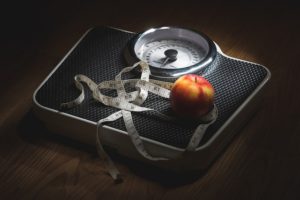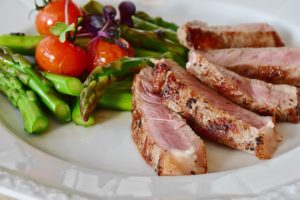Let’s get ready to rumble. In the red corner weighing in at less than 50 grams of carbs per day is the ketogenic diet. It’s the undisputed champion fad diet taking over every health food section at grocery stores. In the blue corner weighing in at…. wait, we’re not sure… is the paleolithic diet. It’s hunting and gathering as much as possible to nourish you, caveman style. It’s gonna be a good clean fight between keto and paleo because both require absolutely zero processed foods. Who will win the title of best diet?

What is a ketogenic diet?
Nicknamed “keto”, this diet is low in carbohydrates and high in fat. It requires discipline, and I’m speaking from experience. In March 2018, I began a 6 week keto diet that helped me lose 30 lbs. Less than 10% of my diet came from carbohydrates, including natural sugars that come from fruits and vegetables. To give you perspective, one banana has 27 grams of carbs. That is over half of the daily intake. I tracked my macros using “My Fitness Pal”; the goal was to maintain a daily caloric ratio of approximately 5% carbohydrates, 20% protein and 75% fat. I achieved a metabolic state of ketosis by starving my body of glucose, requiring it be fueled by fat. Consequently, my body burned its own fat resulting in a dramatic weight loss.
I became interested in the ketogenic diet after reading Why We Get Fat by Gary Taubes. He is an investigative science and health journalist who argues the current obesity epidemic is due to the consumption of simple carbohydrates. After the Industrial Revolution, changes in agriculture made processed foods and sugary foods more accessible than ever before. Taubes makes a convincing case for why the calories in- calories out model for weight loss is bad nutritional science. Counting calories neglects the effect of insulin on our fat tissue. It is more important to evaluate how our bodies are using energy, rather than restricting ourselves to a calorie deficit to lose weight.
What are the challenges of a ketogenic diet?
Carbohydrate restricting is difficult long term. No pizza, cookies, or cereal allowed! Be careful with yo-yoing on and off of a ketogenic diet because you will not stay in “ketosis”. It is easy to accidentally sabotage the ketogenic diet by eating a few too  many carbs. Some people who adhere to a ketogenic diet complain of keto flu when they first begin. I felt fatigued for the first few days of eating low-carb, high-fat.
many carbs. Some people who adhere to a ketogenic diet complain of keto flu when they first begin. I felt fatigued for the first few days of eating low-carb, high-fat.
Keto flu isn’t dangerous, and it can be prevented by drinking plenty of water and getting enough sleep. It can be dangerous, however, if your ketone levels spike too high. Another downside of the keto diet is that it can cause constipation due to the lack of fiber from whole grains. You can get enough fiber by eating lots of low carb vegetables and seeds. It should also be mentioned that this diet is not suitable for those who are pregnant, nursing or diabetic.
What is a paleolithic diet?
 Nicknamed “paleo”, this diet emphasizes whole foods including all fruits and vegetables, grass-fed meat, wild caught fish, eggs, nuts, and seeds. It mimics the food eaten by early humans who were hunter-gatherers, hence its other nickname, the “ancestral diet”. Paleo omits all dairy, gluten, beans and legumes. This diet became popular after Dr. S Boyd Eaton and his co-authors argued that many modern gastrointestinal issues and diseases are a result of today’s eating habits. They believed that since human’s genetic makeup was established during the Paleolithic era, our bodies were built to eat like cavemen.
Nicknamed “paleo”, this diet emphasizes whole foods including all fruits and vegetables, grass-fed meat, wild caught fish, eggs, nuts, and seeds. It mimics the food eaten by early humans who were hunter-gatherers, hence its other nickname, the “ancestral diet”. Paleo omits all dairy, gluten, beans and legumes. This diet became popular after Dr. S Boyd Eaton and his co-authors argued that many modern gastrointestinal issues and diseases are a result of today’s eating habits. They believed that since human’s genetic makeup was established during the Paleolithic era, our bodies were built to eat like cavemen.
The paleo diet is known for supporting healthy digestion and reducing food allergies, sensitivities, and inflammation. I tried the paleo diet after successfully concluding my keto diet in April 2018. I found the paleo diet more flexible and satisfying than the ketogenic diet. I was able to enjoy sweet potatoes, carrots, grapes and bananas. I felt strong, energized and clear-minded. It seemed like the ketogenic diet had reset my body. I was able to fuel myself using carbohydrates, as well as, fat and protein, without developing the intense cravings for sugar that I once suffered from. Paleo freed me to develop a healthier relationship with food… and appreciate the flavors of roasted vegetables!
What are the challenges of a paleo diet?
The paleo diet does not guarantee weight loss. You can still overeat and risk gaining instead of losing. Due to the complete elimination of dairy from this diet, it is difficult to acquire enough calcium and vitamin D. It is important to eat enough dark green vegetables like broccoli. In addition, there are risks associated with eating large amounts of meat. Excess consumption of saturated fat and cholesterol are not good for your cardiovascular health. You also miss out on the fiber, vitamins, and minerals that come from whole grains.
Which diet is best?
Many consider paleo a lifestyle and keto a diet. In my opinion, paleo is much easier to follow in the long run. Ketosis can be a fragile state that is difficult to maintain without strict meal planning. Overall, dieticians do not recommend cutting out entire food groups. When considering a diet for yourself, consider what is the most sustainable. The goal should be to develop a healthy relationship with food that leads to a healthy lifestyle.